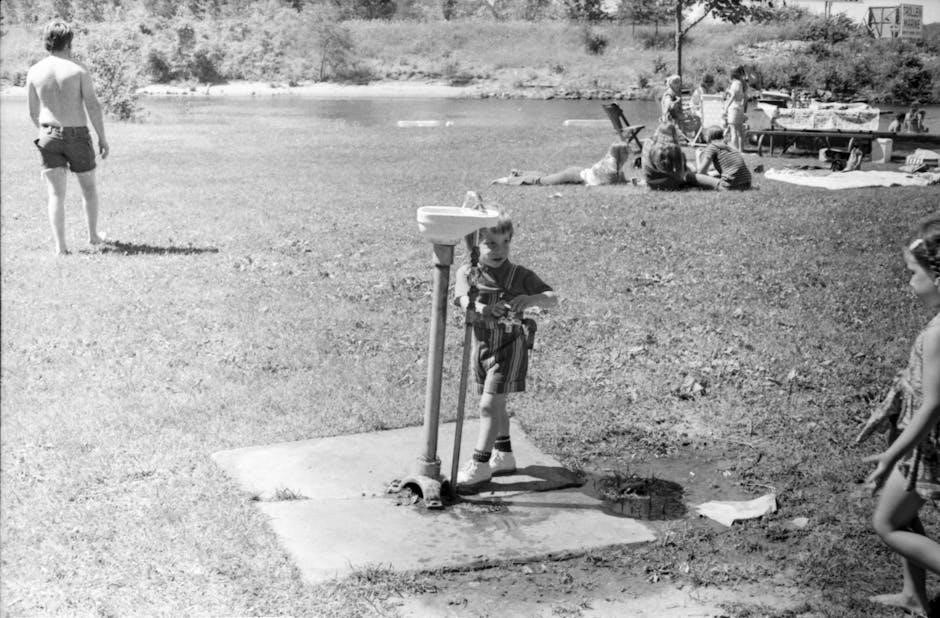A Young People’s History of the United States is an adaptation of Howard Zinn’s classic, offering a fresh perspective on U.S. history for young readers. It highlights the stories of workers, enslaved people, immigrants, and marginalized groups, providing a comprehensive and inclusive narrative. This revised edition includes new contributions by Ed Morales and Rebecca Stefoff, ensuring a modern and insightful exploration of America’s past.
Background of the Original Book
A People’s History of the United States, written by Howard Zinn, was first published in 1980 and became a groundbreaking work in American historical literature. The book challenged traditional narratives by focusing on the experiences of ordinary people, including workers, enslaved individuals, and marginalized groups. It covered events from Christopher Columbus’s arrival to the late 20th century, emphasizing labor movements, civil rights struggles, and the impact of imperialism. Zinn’s critical perspective on U.S. history resonated widely, making the book a seminal work for those seeking alternative viewpoints. Its success led to adaptations, including versions for young readers, ensuring its ideas reached broader audiences.
The Adaptation for Young Readers
A Young People’s History of the United States is an adaptation of Howard Zinn’s original work, tailored for younger audiences while retaining the core themes and critical perspective. Rebecca Stefoff skillfully simplifies the language and structure, making complex historical events accessible to middle-school readers. The adaptation maintains the original’s focus on marginalized voices, ensuring that the stories of workers, enslaved people, immigrants, and women remain central. This version also includes engaging narratives and supplementary materials, such as vocabulary lists and activities, to enhance learning. By preserving Zinn’s radical approach, the book offers young readers a fresh, inclusive understanding of U.S. history, inspiring them to think critically about the past and its impact on the present.

Structure of the Book
A Young People’s History of the United States is structured chronologically, beginning with Columbus’s arrival and spanning key events up to modern times. The book is divided into two volumes, with the first covering early history to World War II and the second extending to the War on Terror. Each chapter focuses on specific eras, incorporating primary sources and the voices of ordinary people to provide a detailed, engaging narrative. The PDF version includes full-page layouts, making it accessible for young readers to explore U.S. history comprehensively.
Starting from Christopher Columbus’s Arrival
A Young People’s History of the United States begins with Christopher Columbus’s arrival in the Americas, but unlike traditional narratives, it presents this event through the eyes of the Arawak Indians. This perspective highlights the indigenous peoples’ experiences and the profound impact of Columbus’s voyage. The book challenges the conventional hero narrative, instead emphasizing the displacement, violence, and exploitation that followed. By starting with this critical moment, the text sets the tone for a history that prioritizes the voices of marginalized communities. This approach encourages young readers to question dominant historical accounts and engage with a more inclusive understanding of the past.
Coverage of Key Historical Events
A Young People’s History of the United States delves into pivotal moments in American history, offering a detailed yet accessible narrative for young readers. The book examines the struggles for workers’ rights, women’s suffrage, and civil rights, highlighting how ordinary people shaped these movements. It also explores the impact of U.S. imperialism and modern-day protests against it. By weaving together these key events, the text provides a comprehensive understanding of the nation’s development. The inclusion of diverse perspectives ensures that the history presented is both inclusive and engaging, allowing young readers to connect with the past on a deeper level. This approach makes history relatable and relevant for the next generation.
Key Themes and Perspectives
A Young People’s History of the United States emphasizes the voices of marginalized groups, including workers, enslaved people, immigrants, women, and Native Americans. It challenges traditional narratives by highlighting their struggles and contributions, offering a more inclusive view of U.S. history. This perspective encourages young readers to understand the diverse experiences that shaped the nation.
Viewpoints of Workers and Enslaved People
A Young People’s History of the United States sheds light on the often-overlooked struggles and contributions of workers and enslaved people. The book explores how enslaved individuals resisted oppression and fought for freedom, while workers organized movements to demand fair wages and better working conditions. These narratives challenge traditional historical accounts by centering the perspectives of those who endured exploitation and injustice. By highlighting their resilience and activism, the text reveals how their efforts shaped the course of U.S. history. This approach ensures that young readers gain a deeper understanding of the sacrifices and struggles that laid the foundation for modern social justice movements.
Stories of Immigrants and Women
A Young People’s History of the United States highlights the vital roles of immigrants and women in shaping the nation’s history. The book shares personal narratives of immigrants who arrived in America seeking opportunity but often faced discrimination and hardship. It also explores the struggles and achievements of women, from the fight for suffrage to their contributions in labor movements and civil rights. By amplifying these voices, the text reveals how their experiences shaped the country’s cultural and social landscape. These stories challenge traditional historical narratives, offering a more inclusive and nuanced understanding of U.S. history.
Representation of Black, Latino, Asian, and Native Americans
A Young People’s History of the United States emphasizes the often-overlooked contributions and struggles of Black, Latino, Asian, and Native Americans. It delves into the resilience of Native Americans against colonialism and displacement, the vibrant cultural impacts of Latino communities, and the integral role of Asian Americans in building the nation’s infrastructure. The book also sheds light on the Civil Rights Movement and the ongoing fight for racial justice. By centering these narratives, the text provides a more complete and truthful account of U.S. history, ensuring diverse voices are heard and valued. This representation fosters a deeper understanding of the multicultural fabric of America.
Impact of Ordinary People on U.S. History
The book underscores the transformative power of ordinary people in shaping U.S. history. From workers fighting for labor rights to enslaved individuals resisting oppression, these narratives highlight how collective action led to significant change. Immigrants, women, and activists are portrayed as key drivers of progress, challenging injustice and demanding equality. By focusing on grassroots movements and everyday heroes, the text reveals how their courage and resilience influenced landmark reforms, such as the Civil Rights Movement and women’s suffrage. This perspective inspires young readers to recognize the potential of individual and communal efforts in creating a more just society. Their stories are a testament to the enduring impact of ordinary people on the nation’s evolution.
Rarely Included Stories in Textbooks
A Young People’s History of the United States distinguishes itself by amplifying voices often overlooked in traditional textbooks. It delves into the experiences of workers, enslaved individuals, immigrants, women, and Native Americans, offering a more inclusive narrative. Stories like the Arawak Indians’ perspective on Columbus’s arrival challenge conventional historical accounts. The book also explores labor movements, civil rights struggles, and the contributions of marginalized groups, providing a richer understanding of U.S. history. By recovering these often-ignored narratives, the text invites young readers to engage with a more authentic and diverse portrayal of the nation’s past, fostering empathy and a deeper connection to the complexities of American history.

The Adaptation Process
Rebecca Stefoff adapted Howard Zinn’s original text for young readers, ensuring accessibility while maintaining the book’s core themes. Ed Morales added new insights, enhancing the historical context.
Role of Rebecca Stefoff in Adapting the Content
Rebecca Stefoff played a pivotal role in adapting Howard Zinn’s A People’s History of the United States for young readers. Her work ensured the original themes of marginalized voices, workers’ rights, and overlooked histories were preserved while making the content accessible to a younger audience. Stefoff’s adaptation maintained the book’s radical perspective but simplified the language and structure for middle-school readers. She collaborated with Ed Morales to incorporate new scholarship, particularly expanding coverage of Latinx, Native, and Asian American histories. Her efforts ensured the book remained faithful to Zinn’s vision while engaging a new generation of readers with a fresh and inclusive narrative of U.S. history.
Contributions by Ed Morales
Ed Morales significantly enriched A Young People’s History of the United States by contributing new perspectives, particularly on Latinx history. His work added depth to the narratives of Latino Americans, highlighting their cultural contributions and political movements. Morales’s contributions expanded the book’s scope, ensuring a more comprehensive representation of diverse experiences. His insights, based on recent scholarship, provided fresh context to historical events, making the book more relevant to contemporary readers. Morales’s collaboration with Rebecca Stefoff helped maintain the book’s authenticity while broadening its inclusivity, ensuring that young readers gain a more nuanced understanding of U.S. history from multiple viewpoints.
Updates Based on New Scholarship
The revised edition of A Young People’s History of the United States incorporates updates based on new scholarship, ensuring a more accurate and inclusive portrayal of U.S. history. These updates expand the coverage of Latinx history, Native American experiences, and Asian American activism, reflecting the latest research and perspectives. A new chapter dedicated to Latinx history highlights their cultural and political contributions, while expanded sections on Native and Asian American histories provide deeper insights into their struggles and achievements. These updates ensure the book remains a vital resource for young readers, offering a more comprehensive understanding of the diverse forces that have shaped the United States.

Revised and Updated Edition
The revised edition of A Young People’s History of the United States includes a new chapter on Latinx history, expanded coverage of Native and Asian American experiences, and contributions from Ed Morales and Rebecca Stefoff, reflecting updated scholarship for a broader understanding of U.S. history.
New Chapter on Latinx History
The revised edition introduces a new chapter dedicated to Latinx history, exploring the rich cultural contributions, political movements, and struggles of Latino Americans. This addition, contributed by scholar Ed Morales, provides a deeper understanding of the Latinx experience, highlighting their impact on U.S. history. The chapter delves into the diverse backgrounds of Latinx communities, their resilience, and their fight for justice. It also examines the cultural legacy and ongoing influence of Latino Americans, offering a more inclusive narrative of the nation’s past. This new chapter is a significant enhancement, ensuring that young readers gain a fuller appreciation of the multifaceted history of the United States.
Expanded Coverage of Native and Asian American Histories
The updated edition broadens its scope with enhanced narratives on Native and Asian American histories. It delves into the struggles and contributions of Native communities, offering a more nuanced understanding of their experiences. Similarly, the book explores the journeys of Asian Americans, highlighting their cultural impacts and challenges. These expansions provide a richer tapestry of U.S. history, ensuring that young readers encounter diverse perspectives often overlooked in traditional texts. By incorporating these stories, the book fosters a more inclusive understanding of the nation’s development and the roles played by these communities in shaping its identity.

Impact and Reception
A Young People’s History of the United States has become a significant educational resource, praised for its inclusive narratives and cultural relevance. It challenges traditional historical perspectives, resonating with educators and young readers alike, while fostering a deeper understanding of diverse experiences in U.S. history.
Use in Educational Settings
A Young People’s History of the United States has become a valuable resource in educational settings, offering a unique perspective on U.S. history. Teachers and homeschooling parents often use it as a spine for curriculum, complementing it with vocabulary exercises, worksheets, and interactive projects. The book’s engaging narrative and focus on diverse voices make it accessible for middle-school students and young learners. Its structured chapters allow for easy integration into lesson plans, fostering critical thinking and historical awareness. The PDF format enhances accessibility, enabling educators to share materials digitally and incorporate multimedia resources. This adaptability makes it a versatile tool for both traditional classrooms and homeschooling environments.
Cultural Significance and Reviews
A Young People’s History of the United States holds significant cultural value for its unique perspective on U.S. history, challenging traditional narratives by amplifying marginalized voices. The book has been praised for its ability to engage young readers while fostering a deeper understanding of the nation’s past. Critics and educators alike have commended its inclusive approach, highlighting the importance of representation in historical education. Reviews often note its impact on encouraging critical thinking and empathy among students. The revised edition, with contributions from scholars like Ed Morales, further enhances its relevance, making it a trusted resource for both classrooms and personal reading.
Accessing the Book
The book is available in PDF format, including the revised edition, and can be downloaded from various sources, making it accessible for young readers and educators alike.
Availability in PDF Format
A Young People’s History of the United States is widely available in PDF format, including the revised and updated edition by Rebecca Stefoff. This digital version ensures easy access for readers, educators, and students, making it a popular choice for homeschooling and classroom use. The PDF format allows for full-page reading, enabling users to explore the comprehensive narrative seamlessly. Many online platforms offer free or paid downloads of the book, catering to diverse audiences. This accessibility has made the text a valuable resource for those seeking alternative perspectives on U.S. history, emphasizing the voices of workers, enslaved people, immigrants, and marginalized communities. The PDF version is particularly favored for its portability and convenience.
Additional Resources and Related Books
Readers of A Young People’s History of the United States can explore additional resources, including teaching guides and study materials, to enhance their understanding. Roxanne Dunbar-Ortiz’s An Indigenous Peoples’ History of the United States for Young People is a highly recommended companion text, offering a focused perspective on Native American experiences. Other related books include Howard Zinn’s original A People’s History of the United States and Voices of a People’s History of the United States, which provide deeper insights and primary sources. These resources, along with the PDF availability of the young readers’ edition, create a comprehensive toolkit for educators and students seeking diverse historical narratives.
